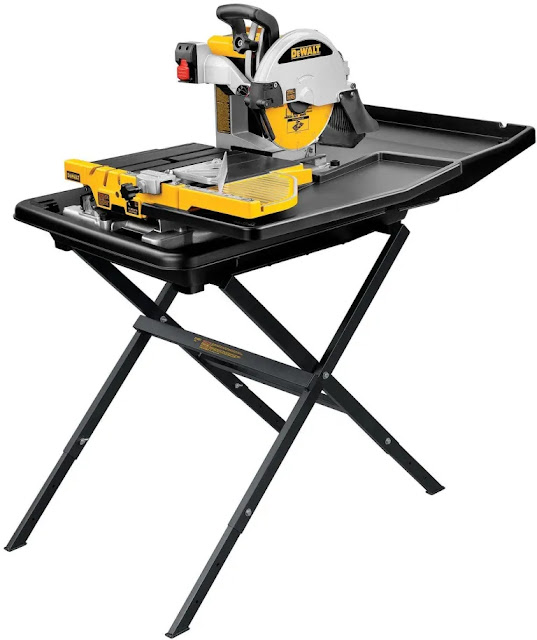Introduction
If you're embarking on a home improvement project that involves tile installation, you'll quickly realize the importance of having the right tools. One such indispensable tool is the tile saw. In this guide, we will take you through everything you need to know about tile saws, from choosing the right one to mastering the art of tile cutting. Let's dive in!
Get lifetime Access to My Private Prompts Library: Click Here
Tile Saws: What Are They?
Tile saws are specialized tools designed for cutting through ceramic, porcelain, and stone tiles with precision and ease. These versatile machines have become a staple in the toolkit of both professionals and DIY enthusiasts, making the task of tile installation efficient and precise.
Types of Tile Saws
Wet Tile Saws
Wet tile saws are the most common choice for tile cutting. They use water to cool the blade, reducing dust and preventing the tile from overheating during cutting.
Dry Tile Saws
Dry tile saws are suitable for smaller projects. Unlike wet saws, they do not use water, which makes them more portable but also results in more dust.
Bridge Tile Saws
Bridge tile saws are ideal for cutting large tiles or slabs. They offer a stable platform for precision cuts.
Handheld Tile Saws
Handheld tile saws are compact and convenient for smaller jobs and touch-ups.
How to Choose the Right Tile Saw
Selecting the right tile saw is crucial for the success of your project. Consider the following factors:
Tile Type: Different tile materials require specific saw types. Ensure your chosen saw is compatible with the tile you're working with.
Blade Size: Blade size determines the depth of your cuts. Choose a blade that accommodates your project's requirements.
Wet or Dry: Decide whether you prefer a wet or dry saw, taking into account the level of dust and water management you can handle.
Cutting Capacity: Ensure the saw can handle the size and thickness of your tiles.
Price and Quality: Invest in a quality saw within your budget. A reliable saw will save you time and effort in the long run.
Brand Reputation: Research the reputation of the manufacturer. A well-known brand often signifies a reliable product.
User-Friendly Features: Look for features like adjustable fences and miter gauges for precise cuts.
Reviews and Recommendations: Read reviews and seek recommendations from professionals or fellow DIYers.
Using a Tile Saw: Step by Step
Now that you've chosen the right tile saw, let's walk through the basic steps for using it effectively.
Safety First: Always wear safety gear, including safety glasses and ear protection, to safeguard against potential hazards.
Mark Your Tile: Use a pencil or marker to mark the cutting line on the tile. Ensure your marks are clear and accurate.
Prepare the Saw: Set up your tile saw according to the manufacturer's instructions, including blade installation and water source (for wet saws).
Position the Tile: Place the marked tile on the cutting platform or table, aligning the cutting line with the blade.
Start Cutting: Turn on the saw and slowly push the tile towards the blade. Maintain a steady and controlled motion to ensure a precise cut.
Cooling Water (for Wet Saws): If you're using a wet saw, ensure a constant flow of cooling water to prevent the blade from overheating.
Complete the Cut: Allow the blade to complete the cut and guide the tile through the blade until you've achieved the desired cut.
Turn Off the Saw: After cutting, turn off the saw and wait for the blade to come to a complete stop before removing the tile.
FAQs About Tile Saws
Q: How do I choose the right blade for my tile saw?
A: Select a blade with the appropriate size and material for your tile type. Diamond blades are a common choice for various materials.
Q: Can I use a wet saw for dry cutting?
A: Wet saws are designed for wet cutting. Dry cutting with a wet saw may damage the motor and blade.
Q: How can I prevent chipping while cutting tiles?
A: To prevent chipping, use a sharp blade and cut at a slower speed. You can also use masking tape along the cut line for added protection.
Q: Are tile saws safe for beginners?
A: With proper training and safety precautions, beginners can use tile saws safely. However, it's essential to learn the tool's operation and follow safety guidelines.
Q: What maintenance does a tile saw require?
A: Regular maintenance includes cleaning the water reservoir (for wet saws), changing the water pump, and ensuring the blade remains sharp.
Q: Can I use a tile saw to cut other materials besides tiles?
A: While tile saws are designed for tiles, some models can cut other materials like glass and certain metals with the appropriate blade.
Conclusion
In conclusion, a tile saw is an invaluable tool for anyone involved in tile installation projects. Choosing the right saw and learning how to use it effectively will ensure precise cuts and a successful outcome. Remember to prioritize safety and follow the manufacturer's guidelines for your specific tile saw model.
If you found this guide helpful, please hit the like button. For more exclusive content and access to my private prompts library, click here.

Comments
Post a Comment